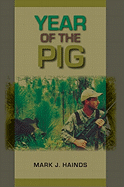
The image of pigs as the lazy, self-indulgent sloths of the animal kingdom lives more in myth than fact. While it is true that sows will pop out more piglets than the most fertile rabbit, the feral pig will also show particular finesse in evading capture by would-be hunters, thus avoiding destiny with the barbecue. As bottom feeders, wild pigs will root and wallow, pillage and destroy, causing even greater damage than a stampede of cattle. In fact, as Mark J. Hainds concludes in his yearlong hunting travelogue, Year of the Pig, there is strong ecological justification for saying good riddance to feral pigs.
As a research associate and forester at Auburn University's Solon Dixon Forestry Center, Hainds knows a thing or two about the damage feral hogs can cause. He has witnessed the destruction caused by pigs to longleaf pine forests, to farm crops and to the native flora of the southeastern U.S. Hainds's hunting journey occurs in 2007, during the Chinese Year of the Pig, beginning as a project to kill a pig in states with established populations and ending as a 10-state hunt. Death from bow, gun or knife--name it and Hainds has likely accomplished his task with a studied hobbyist's glee, a marksman's delicate precision and a comedian's dry humor.
"Pig hunting should play a vital role in controlling pig populations," writes Hainds. "Hunters must resist the temptation to move pigs to areas that are currently pig free." The ecological and economic effects may be overwhelming, reducing biological diversity by outstripping native species and changing the face of our forests forever. --Nancy Powell, freelance writer and technical consultant

